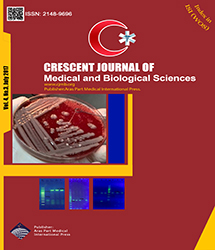Jul 2017, Vol 4, Issue 3

Advanced Search

For Author's & Reviewer's
Poll
How do you find the scientific quality of the published articles on our web site?
| Editorial | |
| Occupational Exposures to Anesthetic Gases in Operating Room | |
| Marzieh Marahem1, Haleh Farzin2, Majid Seyedghodraty3, Bushra Ahmed Hamdi4 | |
| 1Master of Medicine Physiology, Tabriz University of Medical Sciences, Tabriz, Iran 2Assistant of Anesthesiology, Tabriz University of Medical Sciences, Tabriz, Iran 3PhD of Medicine Physiology, Imam Reza Hospital, Tabriz University of Medical Sciences, Tabriz, Iran 4Department of Clinical Analysis, College of Pharmacy, Hawler Medical University, Erbil, Iraq |
|
|
CJMB 2017; 4: 090–091 Viewed : 4455 times Downloaded : 4019 times. |
|
| Full Text(PDF) | |
| Abstract | |
Despite the significant role of environment in human safety, the impact of operating room environment on staff health was considered in the middle of 1990s.1 Operating room staff, particularly women are among high risk groups due to exposure to chemicals, ionizing radiation,2 drugs, pathogens-induced blood infection, needle stick injuries and contact with contaminated secretions, blood and body fluids.3,4 However, one of the occupational hazards is exposure to anesthetic agents.5 Anesthetic gases are the primary source for hospital air contamination.6 These gases are rapidly eliminated from the body due to their low solubility.5 Therefore, there have been reported several neurological toxic, immunosuppressive, reproductive effects, carcinogenic, genetic damage, liver-kidney and respiratory adverse effects.7 Repeated exposure may lead to cellular damage, increases in cell proliferation, hyperplasia and finally tumor development.5 The effects of chronic exposure to anesthetic gases on the medical staff and team"s health and well-being are of prime important. In survey of occupational exposures literature from 2000 to 2016, general information about occupational exposures to anesthetic gases in operating room was collected. The most important finding of the articles reviewed and published concerning the dangers of anesthetic gases in the operating room staff is occupational exposure to anesthetic gases, including genotoxic damage and fetal abortion and abnormalities and liver toxicity in the operating room staff. Genotoxity is associated with waste inhaled anesthetic.8 Significant amount of inhaled anesthetic gases was found in dental surgery clinics, resulting in spontaneous abortion and liver disease.9 Primary studies on N2O toxicity due to exposure with N2O showed reproductive problems, but this concern was not demonstrated.10 The approaches for diminishing of operating room staff exposure-related risks include appropriate guidelines such as lowering their work hours in operating rooms, considering recommended exposure limit for special groups such as pregnant women or those with hepatic dysfunction, providing comprehensive training course, improving ventilation scavenger system, utilizing standard equipment as far as possible and promoting self-awareness. |
Cite By, Google Scholar
Google Scholar
Articles by Marahem M
Articles by Farzin H
Articles by Seyedghodraty M
Articles by Ahmed Hamdi B
PubMed
Articles by Marzieh Marahem
Articles by Haleh Farzin
Articles by Majid Seyedghodraty
Articles by Bushra Ahmed Hamdi
Submit Paper
Online Submission System CJMB ENDNOTE ® Style
CJMB ENDNOTE ® Style
 Tutorials
Tutorials
 Publication Charge
Medical and Biological Research Center
About Journal
Publication Charge
Medical and Biological Research Center
About Journal
Online Submission System
 CJMB ENDNOTE ® Style
CJMB ENDNOTE ® Style
 Tutorials
Tutorials
 Publication Charge
Medical and Biological Research Center
About Journal
Publication Charge
Medical and Biological Research Center
About Journal
Publication Information
Publisher
Aras Part Medical International Press Editor-in-Chief
Arash Khaki
Deputy Editor
Zafer Akan
Aras Part Medical International Press Editor-in-Chief
Arash Khaki
Deputy Editor
Zafer Akan
Published Article Statistics


















